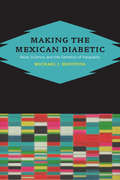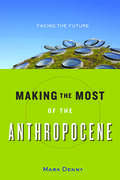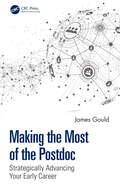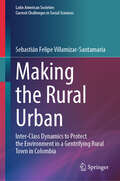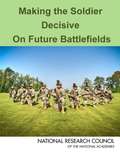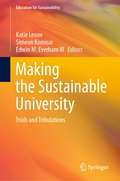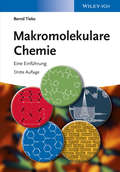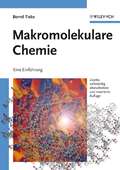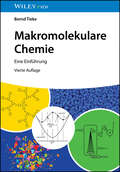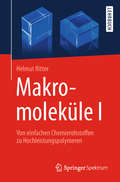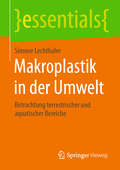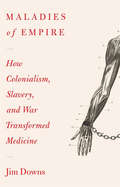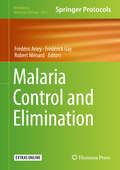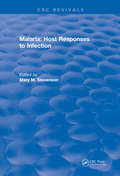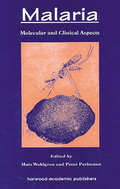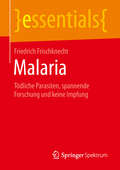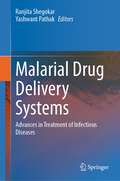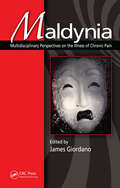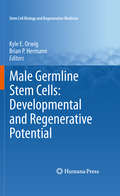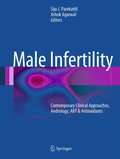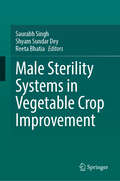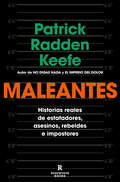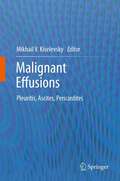- Table View
- List View
Making the Connections: A How-To Guide for Organic Chemistry Lab Techniques
by Anne B. PadiasThe title of the book refers to the making of bonds to build the molecules that are an essential part of organic chemistry. The book is a user-friendly instructional tool designed to facilitate the learning process by including many every-day examples of the chemical principles used in the laboratory.
Making the Mexican Diabetic: Race, Science, and the Genetics of Inequality
by Michael MontoyaThis innovative ethnographic study animates the racial politics that underlie genomic research into type 2 diabetes, one of the most widespread chronic diseases and one that affects ethnic groups disproportionately. Michael J. Montoya follows blood donations from "Mexican-American" donors to laboratories that are searching out genetic contributions to diabetes. His analysis lays bare the politics and ethics of the research process, addressing the implicit contradiction of undertaking genetic research that reinscribes race's importance even as it is being demonstrated to have little scientific validity. In placing DNA sampling, processing, data set sharing, and carefully crafted science into a broader social context, Making the Mexican Diabetic underscores the implications of geneticizing disease while illuminating the significance of type 2 diabetes research in American life.
Making the Most of the Anthropocene: Facing the Future
by Mark DennyHumans have changed the Earth so profoundly that we’ve ushered in the first new geologic period since the ice ages. So, what are we going to do about it?Ever since Nobel Prize–winning atmospheric chemist Paul Crutzen coined the term "Anthropocene" to describe our current era—one in which human impact on the environment has pushed Earth into an entirely new geological epoch—arguments for and against the new designation have been raging. Finally, an official working group of scientists was created to determine once and for all whether we humans have tossed one too many plastic bottles out the car window and wrought a change so profound as to be on par with the end of the last ice age. In summer 2016, the answer came back: Yes. In Making the Most of the Anthropocene, scientist Mark Denny tackles this hard truth head-on and considers burning questions: How did we reach our present technological and ecological state? How are we going to cope with our uncertain future? Will we come out of this, or are we doomed as a species? Is there anything we can do about what happens next? This book• explains what the Anthropocene is and why it is important• offers suggestions for minimizing harm instead of fretting about an impending environmental apocalypse • combines easy-to-grasp scientific, technological, economic, and anthropological analyses In Making the Most of the Anthopocene, there are no equations, no graphs, and no impenetrable jargon. Instead, you'll find a fascinating cast of characters, including journalists from outer space, peppered moths, and unjustly maligned Polynesians. In his bright, lively voice, Denny envisions a future that balances reaction and reason, one in which humanity emerges bloody but unbowed—and in which those of us who are prepared can make the most of the Anthropocene.
Making the Most of the Postdoc: Strategically Advancing Your Early Career
by James GouldGraduate students and postdoctoral fellows spend upwards of 15 years honing their research skills. However, in all this training, compulsory career and professional development courses are far and few between. In the absence of a formal training curriculum, this co-curricular postdoc guidebook can be used as a manual for aspiring scientists to find career success. Postdocs face many hurdles in their pursuit of research excellence and independence. None more frustrating than making the most of this challenging yet rewarding opportunity. Ultimately, the point of postdoc training is not maintaining a lengthy postdoc tenure but landing a satisfying job. Regardless of what they do in their career, postdocs need to gain and master many skills both directly related to their scientific training and beyond. This book posits that if trainees are motivated and given some practical guidance, they can build a professional reputation while achieving a successful postdoc experience. Based on the personal experiences of the author, this book logically outlines the flow of the postdoc experience from beginning to end by providing actionable advice on how to get the most out of postdoctoral training while laying out strategies for choosing the right research environment to thrive along with planning, and executing, a successful postdoc tenure. Written for current and future postdocs, as well as their mentors, this book covers what they need know, and do, to strategically advance in their early research career. Key Features: Practical and actionable advice from an author that has experienced PhD and postdoc training, and is now directing a postdoc office at a world-renowned research institution Methodical approach most readers can readily adapt for their own purposes Specifically written for current and future STEM postdocs while being agnostic of the research field Dr. James Gould, PhD is Director of the HMS/HSDM Office for Postdoctoral Fellows at Harvard Medical School (HMS) where he has implemented research, career, and professional development programs and policies forHMS-affiliated trainees since 2011. Prior to HMS, Dr. Gould completed two postdoc fellowships at the National Cancer Institute of the NIH where he became involved in training affairs and studied cancer metabolism. Dr.Gould received his BS in Biotechnology/Molecular Biology from Clarion University of Pennsylvania and his PhD in Biochemistry and MolecularBiology from the University of Louisville.
Making the Rural Urban: Inter-Class Dynamics to Protect the Environment in a Gentrifying Rural Town in Colombia (Latin American Societies)
by Sebastián Felipe Villamizar-SantamaríaThis book takes the small rural town of La Calera, in the outskirts of the Colombian capital of Bogotá, as a case study to analyze how residents from different social classes – wealthier ex-urban newcomers arriving to traditionally peasant and rural areas – interact to decide how nature will be used in the face of further urban expansion. Contrary to the conflicts in other gentrification cases, including those of “green” gentrification, this book shows how newcomers and longtimers in La Calera use environmental concerns to bridge social class rifts and push the state to provide water, public space, and decision-making power. Residents see abundant ecological resources like water and land around them, but they do not have access to aqueducts, green public space or power over planning decisions affecting the distribution of these resources. As a response, and to challenge the state more effectively, newcomers and longtimers create inter-class alliances through what the author calls third nature: the way residents try to both protect and keep using existing ecological goods. To do so, despite high levels of class inequality, residents had a similar goal of protecting ecological resources around them by intervening in the physical and political landscapes against a state that induces scarcity, selectively enforcing environmental policies to the detriment of Calerunos. As cities all around the Global South continue to grow, urban expansion posits a threat to the environment by transforming agricultural and protected areas into denser residential or touristic spaces. Moreover, as natural resources become scarcer in the face of climate change, inequality might further existing environmental privileges and vulnerabilities. By examining closely how Calerunos bridge class inequalities for environmental reasons, this case highlights processes that inform other gentrifying rural spaces around the world.
Making the Soldier Decisive on Future Battlefields
by Division On Engineering Physical SciencesThe U. S. military does not believe its soldiers, sailors, airmen, and marines should be engaged in combat with adversaries on a "level playing field. " Our combat individuals enter engagements to win. To that end, the United States has used its technical prowess and industrial capability to develop decisive weapons that overmatch those of potential enemies. In its current engagement--what has been identified as an "era of persistent conflict"-- the nation's most important weapon is the dismounted soldier operating in small units. Today's soldier must be prepared to contend with both regular and irregular adversaries. Results in Iraq and Afghanistan show that, while the U. S. soldier is a formidable fighter, the contemporary suite of equipment and support does not afford the same high degree of overmatch capability exhibited by large weapons platforms--yet it is the soldier who ultimately will play the decisive role in restoring stability. Making the Soldier Decisive on Future Battlefields establishes the technical requirements for overmatch capability for dismounted soldiers operating individually or in small units. It prescribes technological and organizational capabilities needed to make the dismounted soldier a decisive weapon in a changing, uncertain, and complex future environment and provides the Army with 15 recommendations on how to focus its efforts to enable the soldier and tactical small unit (TSU) to achieve overmatch.
Making the Sustainable University: Trials and Tribulations (Education for Sustainability)
by Katie Leone Simeon Komisar Edwin M. Everham IIIThis book documents strategies for universities engaging sustainability challenges through the education of global citizens on topics such as climate change, habitat alteration, species loss, resource depletion and contamination, food access and sovereignty, economic equity, and energy use. Different disciplines and operational units often have disparate ideas in mind when they work toward advancing sustainability. For example, some disciplines focus on environmental challenges (identifying impacts to ecosystems, mitigation and remediation strategies), some on greening of industrial and commercial practices while others address social equity—often there is little effort to connect these pieces especially while considering economic impacts. This book examines how Florida Gulf Coast University has attempted to infuse sustainability across curricula and operations as an integrated concept and our successes and shortcomings are instructional for sustainability practitioners on college campuses and other industries in a wide audience.
Makromolekulare Chemie
by Bernd TiekeFür Chemiker, Polymerchemiker und besonders für Chemiestudenten ist die zweite Auflage des Tiekes wieder ein gelungenes und ausgewogenes Lehrbuch über das Basiswissen in der Makromolekularen Chemie. Mit der bereits bewährten Didaktik wird der Stoff der Makromolekularen Chemie in verständlicher Form und klar gegliedert dargestellt. Der Inhalt wurde verbessert, erweitert und aktualisiert. Neu behandelte Themen sind hierbei: lebende kationische und lebende radikalische Polymere, flüssigkristalline Polymere, elektrisch leitende Polymere, Polyelektrolyte, bioabbaubare Polymere und Verarbeitung und Recycling von Polymeren.
Makromolekulare Chemie: Eine Einführung
by Bernd TiekeFür Chemiker, Polymerchemiker und besonders für Chemiestudenten ist die zweite Auflage des Tiekes wieder ein gelungenes und ausgewogenes Lehrbuch über das Basiswissen in der Makromolekularen Chemie. Mit der bereits bewährten Didaktik wird der Stoff der Makromolekularen Chemie in verständlicher Form und klar gegliedert dargestellt. Der Inhalt wurde verbessert, erweitert und aktualisiert. Neu behandelte Themen sind hierbei: lebende kationische und lebende radikalische Polymere, flüssigkristalline Polymere, elektrisch leitende Polymere, Polyelektrolyte, bioabbaubare Polymere und Verarbeitung und Recycling von Polymeren.
Makromolekulare Chemie: Eine Einführung
by Bernd TiekeSeit mehr als 25 Jahren ist dieses Lehrbuch das Standardwerk zum Einstieg in die Makromolekulare Chemie. Kompakt, übersichtlich und verständlich werden die Synthese, Charakterisierung, Eigenschaften und Reaktionen sowie Anwendungen von Polymeren beschrieben. Für die vierte Auflage wurde das Buch komplett überarbeitet, aktualisiert und um wichtige Kapitel erweitert, wie z.B. natürliche Polymere und Biomakromoleküle, Dendrimere, hyperverzweigte Polymere und Sternpolymere, Synthesemöglichkeiten mittels Click-Chemie, Additive für Polymere, selbstheilende Polymere, Elektrospinnen, 3D-Druck von Polymeren und Mikroplastik. Durch die Änderungen sind der Materialaspekt und die technische Seite der Makromolekularen Chemie stärker betont worden. Neben einer Zusammenfassung der wichtigsten Inhalte am Ende jedes Kapitels sind erstmals auch Fragen und Antworten enthalten, die es ermöglichen, das erworbene Wissen selbstständig zu überprüfen und sich erfolgreich auf Prüfungen vorzubereiten. Mit seinem bewährten Konzept ist das Buch der ideale Begleiter für alle Studierenden der Chemie im Haupt- und Nebenfach sowie der Materialwissenschaften. Für Chemiker und Ingenieure, die sich in das Thema schnell einlesen wollen, sei dieses Buch ebenfalls wärmstens empfohlen!
Makromoleküle I: Von einfachen Chemierohstoffen zu Hochleistungspolymeren
by Helmut RitterEin praxisorientiertes Lehrbuch zum nachhaltigen Verständnis über Herstellung und Eigenschaften von Kunststoffen. Auch ökonomische und Umwelt-Aspekte werden umrissen. Das Buch richtet sich an Studierende der Chemie sowie an Forscher in Industrie und Instituten.
Makroplastik in der Umwelt: Betrachtung terrestrischer und aquatischer Bereiche (essentials)
by Simone LechthalerSimone Lechthaler zeigt, dass der Eintrag von Makroplastik in die Umwelt, der bereits in zahlreichen aquatischen und terrestrischen Bereichen nachgewiesen wurde, vollständig durch anthropogenes Handeln bedingt ist und daher ganzheitlich vermieden werden kann. Durch die Persistenz des Werkstoffes kommt es zu einer kontinuierlichen Akkumulation von Makroplastik in der Umwelt. Präventive Maßnahmen müssen daher weitreichend und intensiver thematisiert werden und auch Einfluss auf die (Umwelt-)Bildung nehmen, um den weiteren Eintrag einzugrenzen und möglichst zu verhindern. Die Autorin erläutert, dass die Interaktionen zwischen Makroplastik und der Umwelt noch nicht ausreichend untersucht und gesundheitliche Folgen für den Menschen noch unklar sind, für Tiere jedoch bereits ein Gesundheitsrisiko besteht.
Maladies of Empire: How Colonialism, Slavery, and War Transformed Medicine
by Jim DownsA sweeping global history that looks beyond European urban centers to show how slavery, colonialism, and war propelled the development of modern medicine. Most stories of medical progress come with ready-made heroes. John Snow traced the origins of London’s 1854 cholera outbreak to a water pump, leading to the birth of epidemiology. Florence Nightingale’s contributions to the care of soldiers in the Crimean War revolutionized medical hygiene, transforming hospitals from crucibles of infection to sanctuaries of recuperation. Yet histories of individual innovators ignore many key sources of medical knowledge, especially when it comes to the science of infectious disease. Reexamining the foundations of modern medicine, Jim Downs shows that the study of infectious disease depended crucially on the unrecognized contributions of nonconsenting subjects—conscripted soldiers, enslaved people, and subjects of empire. Plantations, slave ships, and battlefields were the laboratories in which physicians came to understand the spread of disease. Military doctors learned about the importance of air quality by monitoring Africans confined to the bottom of slave ships. Statisticians charted cholera outbreaks by surveilling Muslims in British-dominated territories returning from their annual pilgrimage. The field hospitals of the Crimean War and the US Civil War were carefully observed experiments in disease transmission. The scientific knowledge derived from discarding and exploiting human life is now the basis of our ability to protect humanity from epidemics. Boldly argued and eye-opening, Maladies of Empire gives a full account of the true price of medical progress.
Malaria Control and Elimination (Methods in Molecular Biology #2013)
by Robert Ménard Frédéric Ariey Frédérick GayThis detailed book serves to provide a global overview of the goals, rationale, and scientific basis for malaria control and elimination, as well as tools, methods, and strategies to that end. Opening with a section on malaria epidemiology, the volume continues by covering tools that are critical to malaria management, anti-malarial drugs and resistance to these drugs, vaccination approaches against malaria, vector control, as well as some perspective on the future of the fight against this devastating disease. Written for the highly successful Method in Molecular Biology series, chapters in this collection feature the kind of practical, hands-on advice that leads to better results in the field. Authoritative and important, Malaria Control and Elimination is a valuable reference for all those involved in malaria control and elimination worldwide, from students to health practitioners and field researchers seeking to make eradication a reality wherever possible.
Malaria: Deadly parasites, exciting research and no vaccination (essentials)
by Friedrich FrischknechtFriedrich Frischknecht gives an insight into malaria and the biological complexity of the parasites that trigger it. The author takes the reader on a journey from the historical discovery of the pathogen to the modern methods of vaccine development. He explains how genetic manipulations help to understand the parasite and to develop novel vaccination approaches. He explains the difficulties that need to be overcome to eradicate malaria.The author: Prof. Dr. Friedrich Frischknecht studied biochemistry at the Freie Universität Berlin and did his PhD on smallpox viruses at the European Molecular Biology Laboratory (EMBL) in Heidelberg. After a research stay at the Institut Pasteur in Paris, he has been head of a research group at the University Hospital in Heidelberg since 2005 and is interested in the molecular basis of the movement of malaria parasites.
Malaria: Host Responses to Infection (CRC Press Revivals)
by Mary M. StevensonThe purpose of this book is to analyze and determine how a host responds to a blood stage malaria infection. It focuses on strategies for anti-malarial vaccination, genetic control of host resistance to malaria, and the contribution of the host genetic background to resistance or susceptibility to malaria. This book is an important reference work for anyone who studies the field of microbiology, immunology, or parasitology.
Malaria: Molecular and Clinical Aspects
by Mats Wahlgren Peter PerlmannMalaria causes more death and disease than any other parasitic pathogen known today. This multiauthored text covers the important areas of malaria research, particularly focusing on those sectors which are of clinical importance for the understanding of the disease, the parasite, and its vector. The chapter authors are all leading experts withi
Malaria: Tödliche Parasiten, spannende Forschung und keine Impfung (essentials)
by Friedrich FrischknechtFriedrich Frischknecht gibt einen Einblick in die Malaria und die biologische Komplexität der sie auslösenden Parasiten. Der Autor nimmt den Leser mit auf eine Reise von der historischen Entdeckung der Erreger zu den modernen Methoden der Impfstoffentwicklung. Dabei erläutert er, wie genetische Manipulationen helfen, den Parasiten zu verstehen und neuartige Impfansätze zu entwickeln. Er erläutert die Schwierigkeiten, die zur Ausrottung von Malaria zu überwinden sind.Der Autor: Prof. Dr. Friedrich Frischknecht hat nach dem Studium der Biochemie an der Freien Universität Berlin am Europäischen Molekularbiologischen Laboratorium (EMBL) in Heidelberg über Pockenviren promoviert. Nach einem Forschungsaufenthalt am Institut Pasteur in Paris leitet er seit 2005 eine Forschungsgruppe am Universitätsklinikum in Heidelberg und beschäftigt sich mit den molekularen Grundlagen der Bewegung von Malariaparasiten.
Malarial Drug Delivery Systems: Advances in Treatment of Infectious Diseases
by Yashwant Pathak Ranjita ShegokarThis book targets new advances in areas of treatment and drug delivery sciences for Malaria. This is the only published book which compiles the complete road map of malarial drug delivery systems along with an overview on the pathology, current state of malaria across the globe, new clinical trials, emerging drugs and evolving novel drug delivery platforms. A wide variety of novel micro-and nano-formulations using promising technologies are being explored to deliver the malarial drug via different administration routes. This book addresses the gap between new approaches and old treatment modalities and how the former is superior in pharmacological performance when tested in in-vitro and in-vivo. Audience from wide range group like from researchers to regulatory bodies can benefit from the compiled information to find out patient needs and addresses a much-needed update to the existing malaria drug delivery research.
Maldynia: Multidisciplinary Perspectives on the Illness of Chronic Pain
by James GiordanoWhether initiated by injury or disease, induced and sustained by changes in the nervous system, or manifested by society and culture, chronic pain can change one's first-person experience of the body and the world, and ultimately impacts cognitions, emotions, and behavior. Many fine medical books address the causes and management of chronic intract
Male Germline Stem Cells: Developmental and Regenerative Potential
by Brian P. Hermann Kyle E. OrwigScientists investigating germ cells have, over the past 15 years, originated discoveries and innovations that give us valuable insights into the mechanisms that regulate not just stem cell function, but human development in its widest sense. With contributions from some of the leading researchers in the field, Male Germline Stem Cells: Developmental and Regenerative Potential assesses the implications of these discoveries for understanding the fundamental biology of germline stem cells as well as their potential for human stem cell-based therapies. This monograph covers many of the fundamental issues now being explored by today's generation of stem cell researchers, including the field's potential for regenerative medicine. Ranging from an assessment of the pluripotency of primordial germ cells and their possible applications in treating testicular cancer, to the recovery of once-mordant fertilization-competent sperm, this volume has it all. It is a reference point for any scientist involved in related research as well as being a timely summation of what could prove to be a hugely exciting and very fruitful area of inquiry.
Male Infertility
by Ashok Agarwal Sijo J. ParekattilA ground-breaking contribution to the literature, Male Infertility: Contemporary Clinical Approaches, Andrology, ART & Antioxidants offers a comprehensive review of well-established, current diagnostic and treatment techniques for male infertility. This state-of-the-art, evidence-based resource incorporates new multidisciplinary and complementary medicine approaches to create a first-of-its-kind guide to treatment strategies involving antioxidants for male infertility. Designed as an easily accessible practical reference for daily use, Male Infertility: Contemporary Clinical Approaches, Andrology, ART & Antioxidants provides a high quality guide for urologists, reproductive endocrinologists, embryologists, andrologists, biologists and research scientists interested in the role that antioxidants play in male infertility.
Male Sterility Systems in Vegetable Crop Improvement
by Saurabh Singh Shyam Sundar Dey Reeta BhatiaThis book covers different male sterility systems employed for genetic improvement of vegetable crops. Various aspects such as cytoplasmic male sterility (CMS), genic male sterility (GMS) and cytoplasmic genic male sterility (CGMS), and their exploitation in hybrid breeding of vegetable crops is also discussed. This book provides the timeline of key breakthroughs made in the male sterility systems and their exploitation in vegetable crop improvement. The information compiled is of great relevance to current need of global food security. Precise genome editing through CRISPR/Cas9 and other advanced techniques has made it possible to engineer male sterility in vegetable crops. Due to the pressing issue of climate change, the diversification of cytoplasm is important and hence, the role of alien cytoplasm in developing novel male sterility systems in vegetable crops is also explored. This book is resourceful for the researchers, students, scientists, teachers and private players interested in hybrid vegetable seed industry.
Maleantes: Historias reales de estafadores, asesinos, rebeldes e impostores
by Patrick Radden KeefeTras No digas nada y El imperio del dolor, Patrick Radden Keefe explora los límites, a menudo imperceptibles, entre lo legal y lo ilegal, a través de doce retratos reales protagonizados por maleantes de medio mundo LIBRO DE LA SEMANA POR EL PERIÓDICO «Keefe hahecho carrera sumergiéndose en personajes fascinantes, en eso es el mejor. [...] En Maleantes regresa con su altísimo rigor periodístico y la misma pasión de siempre por desvelar misterios, con un resultado inconfundible».New York Times Book Review «Un narrador virtuoso».The Washington PostCon el fascinante estilo que le caracteriza, Patrick Radden Keefe ofrece en este libro una compleja panorámica del lado oscuro del ser humano. Aquí retrata, entre otros personajes, al traficante de armas Monzer al-Kassar, apodado «el príncipe de Marbella» y perseguido incansablemente por un agente de la D.E.A., a la controvertida «abogada del diablo» que lucha contra la pena de muerte representando a los peores criminales, al Chapo Guzmán y su vida tras huir de una prisión de alta seguridad, o al célebre delincuente holandés William Holleeder y los esfuerzos de su propia hermana para lograr su encarcelación. Maleantes recoge doce perfiles de estafadores, truhanes, asesinos y rebeldes, gente que nada a contracorriente y cuya vida excepcional, para bien y para mal, invita al lector a reflexionar sobre temas como la esencia del mal, del poder, del crimen y de la corrupción, pero también sobre el coraje de quienes decidieron enfrentarse a ellos. La crítica ha dicho... «Una obra rigurosa y literaria. [...] Honesto y escrupuloso, [Radden Keefe] es la cara y la cruz del periodismo».Marta Ailouti, El Cultural «Lo ha vuelto a hacer. Una no-ficción que se lee como un thriller y se sigue como la trama de una película. [...] La recomiendo mucho».Glòria Aznar, Diari de Tarragona «El catálogo de personajes que desfilan por aquí es digno del Hollywood más oscuro: crímenes, sí, pero también con glamur y carisma».Adrià Puértolas, El Nacional «El periodista narrativo más prestigioso de su generación».Gonzalo Suárez, El Mundo«Un conjunto de relatos con afán literario, como la antología de cuentos de un escritor con voluntad de estilo; solo que aquí prima la verdad, y los hechos de los relatos se ciñen a un concienzudo fact checking».José S. de Montfort, The Objective«La magnífica prosa de investigación de Keefe tiene elementos propios de la crónica literaria y podría recordar un poco a Gay Talese en el sentido de ser un periodista de raza que guarda el deseo de llegar al fondo de la cuestión en lo que tenga entre manos y una gran vocación de observador».Toni Montesinos, La Razón «Con su envidiable manera de mirar y contar, dibuja retratos depersonajes tan paródicos como crueles, estúpidos e insanos, tiernos y horribles. Talento y rigor».Carlos Zanón, La Vanguardia «Un nuevo libro de Keefe significa dejarlo todo y bajar las persianas; estarás pasando páginas durante horas».Los Angeles Times«Maleantes no es solo la muestra de lo buen periodista que es su autor, sino del inmenso poder del reportaje como género. Quizá el mayor don que tiene Keefe como escritor es la comodidad con la que se mueve en terrenos ambiguos, un recordatorio oportuno de que las cosas no son nunca blancas o negras».Toronto Star «Un espectacular libro de periodismo en mayúsculas».Irish Independent
Malignant Effusions: Pleuritis, Ascites, Pericardites
by Mikhail V. KiselevskyMalignant effusions (pleurites, ascites and pericarditis) are some of the most frequent manifestations of dissemination process of malignant tumors. Accumulation of the malignant fluid in serous cavities results in impairment of respiratory and cardiac functions, however long-term evacuation of the fluid leads to severe disorders of homeostasis that may directly cause the patient's death. The aim of this comprehensive book is to provide detailed information of pathogenesis and management of malignant effusions. The current book focuses on three of these categories: pleuritis, acsites and pericarditis. This book, written by recognized experts in the field, provides a detailed overview of current knowledge on this subject. The presented book reports valuable information about malignant effusions to basic and clinical medical specialists in academia, practice, as well as industry. The main topics considered include contemporary diagnostic approaches and modern therapeutic strategies, including conventional drugs, methods of intracavitary adoptive immunotherapy, chemotherapy and hyperthermia, commercial and experimental drugs being still under study. The material is presented in an easy to read and understandable language and uses a plethora of tables and figures. This book is aimed at oncologists, as well as phthisiatrician, surgeons, therapists and physicians of various specializations, who have to make diagnosis and treat effusions during their professional activity, and it will be undoubtedly helpful for interns, post-graduates and Ph.D. fellows of medical centers.

